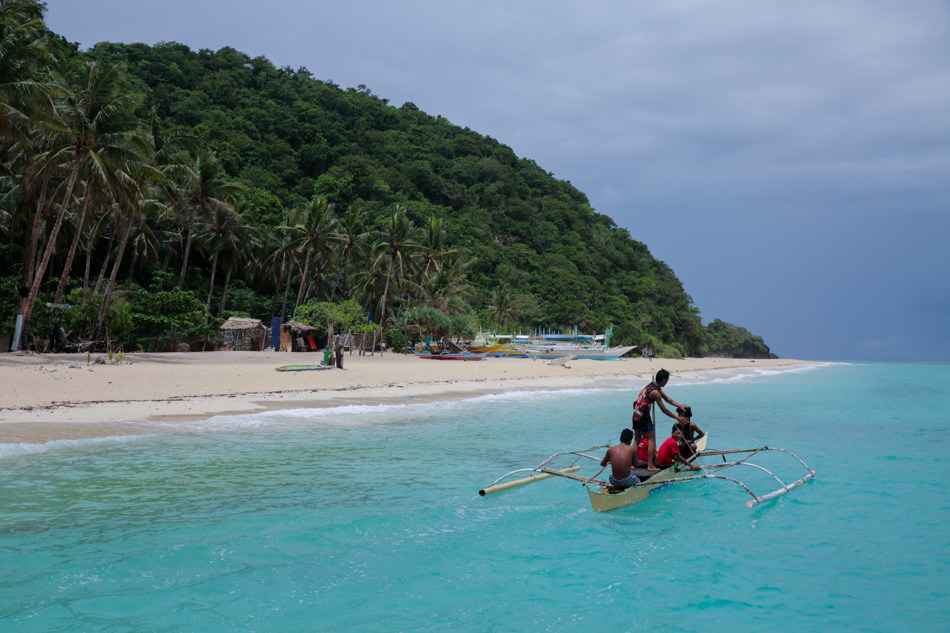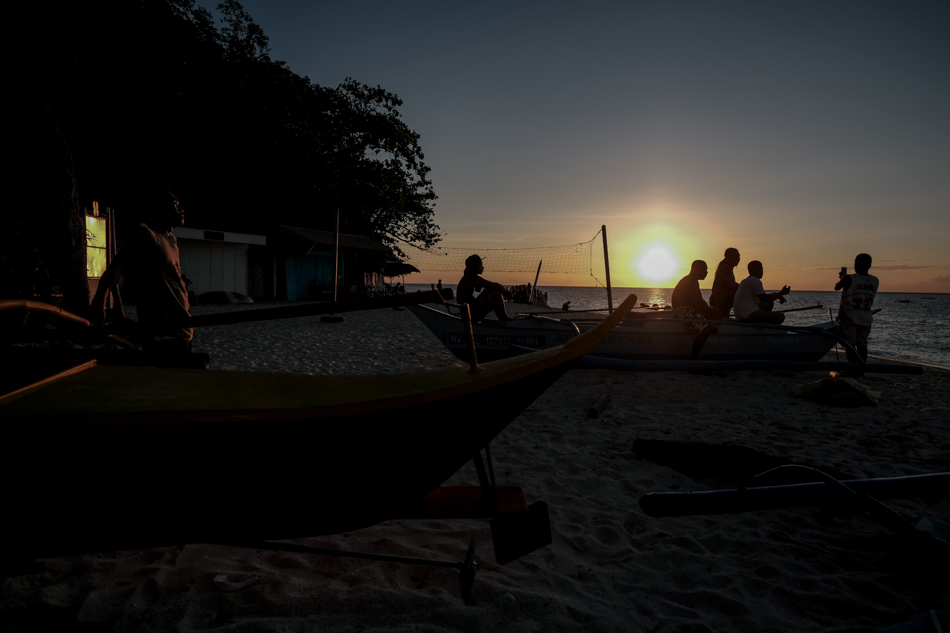










Story by Katrina Domingo
Photographs by Fernando G. Sepe, Jr.
The 4-kilometer stretch of fine white sand that was once brimming with bikini-clad tourists and frantic peddlers had an unusual stillness that Thursday morning of April 26 as blaring party music, hawking cries, and boisterous chatters were replaced by the sound of waves crashing on the empty shore.
The paraws that dotted the island’s shallow waters sailed elsewhere. The masseuse and tattoo artists dismantled their makeshift stalls. The ottomans and beanbags where beachgoers lounged and sunbathed were packed up.
The island, known as one of the prime party destinations in Asia, fell silent. Boracay was closed.
The national government’s order to shut down the island for a half-year rehabilitation took effect on April 26, around two months after a disgruntled President Rodrigo Duterte described the country’s premier tourist destination as a “cesspool.”
Around P4.2 billion will be spent to overhaul the island’s existing road networks and drainage systems, and fund assistance programs for some 36,000 workers who will lose their livelihood during the shutdown.

At least 350 hotels, restaurants, and other tourist establishments operate in the 10-square-kilometer island. Dozens more are being constructed in its 3 barangays: Manoc-manoc, Balabag, and Yapak.
Boracay’s carrying capacity has yet to be determined but local and national officials agree that the island needs to be decongested. The island had a population of over 40,000 in 2017, and at least 3.72 million foreign and local tourists flew to the island in 2017 alone, data from the Civil Aviation Authority of the Philippines (CAAP) show.
Aklan Governor Florencio Miraflores said the provincial government plans to renovate the jetty ports in the towns of Caticlan and Cagban--the main gateways to the island--to regulate the number of people staying in Boracay.
“Gusto naming i-limit ['yung pasok ng tourists]. Meron kaming plano to build an all-weather port with a good ferry system na affordable para may incentive sila na umuwi sa mainland,” Miraflores told ABS-CBN News.
Once ports are upgraded, developers will be required to provide housing units for their workers in the mainland, Miraflores said.
“Nafo-force lang sila [workers] dito tumira kasi wala silang option. [Kaya] Kapag magpapa-construct ka ng hotel, dapat gagawa ka ng barracks sa mainland,” he said.
The port renovation project has yet to be approved by the Aklan provincial board.

Boracay's cesspool problem is rooted in its inadequate and faulty sewage system. After the island was shut down to tourists on April 26, pipes that were illegally discharging sewage into the sea were uncovered.
On May 1, a pipe discharging foul-smelling liquid and white foam was unearthed along White Beach.
The murky liquid flowed from the pipe and formed a puddle on the beach. It was dug up after residents alerted authorities to a foul smell, said Richard Fabila, officer-in-charge of the DENR on the island.
"Siguradong waste water ito kasi mabaho. Kung treated water iyan, hindi 'yan ganiyan kabaho," he said.
(This is surely waste water because of the foul smell. If this were treated water, it would not smell as bad.)
"Waste water ‘yang lumalabas diyan kasi napakabaho ang amoy. Kung para sa rainwater at flooding lang talaga ‘yan, bakit may lumalabas pa rin kahit ang init-init at hindi naman umuulan?”
(Waste water is being discharged from that pipe because it has a foul smell. If that pipe is really for rainwater and flooding, why is it discharging water even when it’s not raining?)
A team from the Department of Public Works and Highways (DPWH) dug into the sand and found a 6-inch diameter blue pipe, cushioned with sand bags to conceal the leak.
“Maiksi lang 'yung tubo, sa sand lang nagdi-discharge. Pero kapag high tide, aabot 'yung discharge sa tubig,” Fabila said.
(The pipe is just short so it just discharges on the sand. But during high tide, the discharge will reach the water.)
A local official said this pipe was built by villagers as part of a drainage system. Residents of Sitio Manggayad chipped in to build the pipe, which was meant to funnel rainwater from the streets to White Beach, said Balabag barangay chairperson Lilibeth Sacapaño.
"Noon kasi walang drainage diyan so nagbabaha sa kanila. Nagpaalam sila sa akin na maglagay ng tubo para hindi sila bahain so sabi ko sige kaya nag-ambag-ambag sila para mailagay 'yun," Sacapaño told ABS-CBN News.
(There was no drainage there before so the area was prone to flooding. When residents asked me if they could put a pipe to reduce flooding in the area, I said go ahead, that’s why they chipped in.)
Sacapaño said she told residents that she would have the pipe removed after it was found to be discharging dirty water. The monitoring of the pipe had been left to the barangay kagawad and other village officials, she said.
Residents reported to a government hotline that at least 3 pipes were discharging waste water from households and commercial establishments into the shores of the 4-kilometer stretch of White Beach.
"Ire-recommend ko sa DENR national na bungkalin buong White Beach para mahanap ‘yang nga pipe na ‘yan," Fabila said.
(I will recommend to the DENR national to excavate the entire White Beach to locate those pipes.)
As of May 18, 3 pipes had been excavated while the 30 other pipes were expected to be unearthed later, DENR Secretary Roy Cimatu said.
"Titingnan namin talaga yan. Huhukayin namin 'yan dahil hindi ko masasabi na cleared talaga [ang Boracay] kung hindi natin mahinto ito," he said.
(We will really look into these. We will excavate those pipes because we can't say Boracay has been cleared if those discharges will not be stopped.)
But the real problem lies within the island’s sewage system - or the lack of it.
The Tourism Infrastructure and Enterprise Zone Authority (TIEZA), the DOT’s infrastructure arm, is set to spend P1.1 billion to build an improved drainage system equipped with interceptors to carry larger volumes of rain and storm water from the island to the sea, former Tourism Secretary Wanda Teo said weeks before she resigned from her post.
The government also wants to complete the rehabilitation of the “cesspool” pipe along Bolabog beach within the 6-month closure.
But the real problem lies within the island’s sewage system - or the lack of it.
Some residents said they were unaware that drainages – meant to flush rain and storm water out of the island - were different from sewers that are connected to treatment facilities. These treatment plants filter and cleanse polluted fluids before discharging them at least 500 meters away from the beach.
Data from the Boracay Island Water Company (BIWC) showed that only 2 out of the 3 barangays on the island had a sewage system.
“It was previously proposed that we should come up with a barangay Yapak sewer and STP but at that time, way back in 2012, development in Yapak was not as progressive as compared to [barangays] Balabag and Manoc-manoc so it was postponed,” said John Michael Santos, General Manager of Boracay Island Water Company.
Of the businesses availing water services from BIWC, only 52 percent were connected to the sewage, while households connected to the sewage were only pegged at 5 percent, Santos said.
Boracay Tubi System Inc., the other water provider on the island, is building a new 1-kilometer water line to increase its water supply capacity but has yet to put up its own sewers.
“'Yung sewage namin, meron kaming sewage treatment plant (STP) sa Fairways so ang tini-treat namin ay 'yung Fairways at 'yung City Mall,” Jephony Gelito, project manager of Boracay Tubi System Inc. (BTSI) told ABS-CBN News.
“'Yung mga residential, kasi wala kaming conveyance line, we syphon tapos du'n namin tini-treat sa Fairways,” he said.
BIWC said it has allocated P1 billion to build a 24-kilometer sewage network in Barangay Yapak next year. BTSI said it is still conducting “feasibility studies” before it builds its own sewage pipes on the island.
The government also issues “discharge permits” to some hotels that have their own sewage treatment plants.
Establishments with discharge permits are allowed to operate even without sewer connections as the document supposedly guarantees that the building is capable of treating its own wastewater.
Santos said allowing hotels to manage their own sewage treatment facilities is not ideal for both tourists and the environment.
“It is not the core competence of hotels to manage a waste water facility. Cumbersome 'yun ha kasi marumi 'yun, ang baho,” Santos said.
“Imagine, if you would be issuing 50 discharge permits, the next question is: Do you have the ability to test day in and day out all these establishments if they are complying,” he added.
As of 2017, nearly 20 hotels on the island received discharge permits from the Department of Environment and Natural Resources.
By July 2018, the government expects all wastewater on the island to be treated and to be “as clean as swimming pool water” before discharged to the sea.

Traffic on the island worsened over the years as more vehicles were brought into a limited road network.
Around 6,000 motorcycles, tricycles, and vehicles ply by the single-lane main road that was designed to accommodate only 1,200 vehicles, Land Transportation Office (LTO) data show.
On Day 1 of the island's closure, the Department of Public Works and Highways (DPWH) began a P500-million road widening project to expand the lane to 12 meters from its current 5-meter width.
“More than 200 establishments ang tatamaan sa 12-meter right of way ng road widening namin sa Boracay. Marami namang compliant, we have yet to find out ilan exactly ang non-compliant,” DPWH Secretary Mark Villar told ABS-CBN News.
All debris must be cleared as soon as possible so that civil works can begin by mid-May, Villar said.
After the clearing, Boracay’s 5.2-kilometer main road is expected to be 6 meters wide, with a 3-meter sidewalk and bike lane on both sides, a blue print from the DPWH showed.
A circumferential road adjacent to the main road will also be constructed to decongest the main thoroughfare, Aklan Governor Florencio Miraflores said.
“This (circumferential road) will become the logistics road para 'yung main road will be just for tourists. Dito dadaan ang mga supply,” Miraflores said.
The LTO has also launched a crackdown on colorum or unregistered public vehicles in a bid to reduce the number of automobiles on the island.


Around 36,000 formal and informal workers either had to leave the island to look for jobs elsewhere or had to apply as cleaners or construction workers under the government’s cash assistance program in Boracay.
Tricycle driver Jonnel Tamayo said he will return to his hometown in neighboring Romblon as the P300 daily wage offered by the government cannot not match his P1,200 daily earnings as a tricycle driver.
"Bahala na ano trabahong makita ko sa Romblon," Tamayo told ABS-CBN News. "Sayang, ang laki pa naman ng kita ko ngayon kasi peak season."
(Who knows what job I'll find in Romblon. It's a pity, I would have earned a lot because it's the peak season.)
Food and beverage supervisor Ronald Marquez said he wanted to stay on the island, but felt that his skills in managing a bar and restaurant will go to waste if he opts to be a beach cleaner for the next 6 months.
“Parang hindi para sa akin 'yung ganung trabaho. Baka magwork na lang muna ako sa ibang lugar, tapos babalik na lang pag bukas na ulit [ang isla sa turista],” he said.
The government said P520 million from the Department of Social Welfare and Development (DSWD) will be used to provide transportation assistance for non-Boracay residents who would like to return to their home towns during the closure.

At least P2 billion from the calamity fund will be used for cash-for-work programs.
Under the program, the Department of Labor and Employment (DOLE), DSWD, and the Department of Public Works and Highways (DPWH) will serve as temporary employers. Only one member of a family may work for each department for 30 days.
“Isang member lang per family ang puwede pumasok sa program para one at a time, para walang duplication, at para ma-accommodate lahat ng 11,000 families,” said Rebecca Geamala, DSWD’s regional director in Western Visayas.
“After they work for 1 month for the DSWD, they may transfer to the DOLE or the DPWH, which will each provide work for another 30 days,” she said.
John Ramirez, a 55-year-old water activity operator who opted to stay on the island with his family, said he was willing to work for the government but was unsure if he will qualify.
He said he can work as a cleaner for the DSWD, but may not be qualified to become a temporary construction worker for the DPWH.
“Susubukan ko mag-apply as construction worker pero hindi ko alam kung tatanggapin nila ako o kung kaya ko pa kasi 55 na ako,” he said.
Some shop owners reported a sharp decline in sales, but said they will try to survive the half-year closure by targeting local consumers.
The daily sales of Real Coffee, famed for its calamansi muffins, dropped to nearly 20 boxes a day from its usual average of 300 boxes.
Boracay’s other tourist staples, the decades-old Merly’s Chori-Burger, and Jonah’s Fruit Shakes, also reported lower sales after the closure took effect.
“From P10,000 a day, P4,000 na lang. Pero walang sarahan kasi wala kaming pagkukuhanan ng income. Kung saan kami nakilala, dito pa rin kami," said Junrey Tampos, who manages their family’s chori-burger stand.
Socio-economic Planning Secretary Ernesto Pernia earlier said Boracay’s closure will mean a loss of P1.96 billion in revenues, but Interior and Local Government Secretary Epimaco Densing III gave a higher estimate of P20 billion during the island’s 6-month closure.
A group of tour operators and resort owners on the island said Boracay’s tourism receipts amounted to about P56 billion in the first nine months of 2017.

The northern part of the island plays host to luxury hotels that boast of their own white sand beachfronts, away from the usually crowded White Beach.
The area was also the target of a government crackdown against companies that built their establishments on natural features.

The Boracay West Cove was demolished in March as the resort carved a portion of the island’s forested hills to make way for rooms and terraces. A natural rock formation was also damaged after it was cemented and renovated to serve as one of West Cove’s lounges.
Environment Secretary Roy Cimatu said he plans to take down the entire resort and replace it with a “marker” that will honor the island’s locals.
“We are asking the locals to submit possible (marker) designs. Dapat makunsulta rin 'yung mga natives because this is really their island,” Cimatu said.

The construction of the Seven Seas resort on Puka Beach, the island’s “last frontier,” was also halted by Cimatu.
The resort, developed by the same builders behind H2O Hotel and Manila Ocean Park behind Quirino Grandstand in Manila, planned to build underwater rooms with aquarium windows that give guests a view of the island’s clear waters.
Resort officials received a stoppage order from the government a day before the shutdown, but locals said small construction activities in the resort still went on a week after the closure.

Cimatu said the government will put up a critical habitat zone on the island’s northern area that will serve as breeding grounds for sea turtles, fruit bats, flying foxes, and other animals found in Boracay’s forests and seas.
Among the establishments that may be affected by the environment zoning are:
Representatives of the establishments said they will support the government’s breeding ground project, but asked officials to provide more specific details about the plan so that they can adjust their operations accordingly.

Boracay originally had 16 forestlands and 9 wetlands, but based on the Department of Environment and Natural Resources (DENR) survey on April 4, all the wetlands have disappeared while the remaining 5 inland bodies of water are already surrounded--if not wiped out--by shops, resorts, or illegal settlers.
The wetlands are vital to the island as these serve as catch basins that naturally filter storm water before it is released to the sea.
Seventy-three-year-old Jimmy delos Santos and his family are among those who erected their homes on a wetland.
Delos Santos’ family occupies a 487-square-meter lot near a creek in Manoc-manoc that used to be a lake. He said he was born and raised in the same shanty built by his grandfather long before Boracay was marketed as a prime tourist destination.
“Noong araw, lilinisan mo lang 'yung lupa, tatanggalin mo lang 'yung mga kahoy, palagyan mo lang ng pangalan na para sa iyo, magiging sa iyo na iyon (lupa) kasi lagyan ka ng tax declaration na sa iyo na iyon,” Delos Santos said while showing ABS-CBN News copies of the tax receipts reflecting their decades-long real property tax payments for the lot.
Delos Santos said he is willing to demolish the house he has lived in for over 7 decades if the government provides a decent relocation site within the island, and if large hotels and resorts situated in forestlands and wetlands will be the first to go.
“Ang sa akin lang, kung ipagiba ang (mga bahay sa) wetland, lahat. Pantay-pantay (dapat). Dahil ang mahirap, once ipagiba nila, paano pa ipatayo nila e wala nang pera. Makakabili pa ba sila ng kahoy? Paano nila gagawin na magpatayo pa ng bahay?” Delos Santos said.
“Ang sitwasyon namin dito ay kung malaking tao ay parang walang issue 'yung kanilang building sa wetland. Ang mga maliliit na bahay ay 'yun ang natutukan nila. Ang malalaki ay wala,” he said.
Environment Secretary Roy Cimatu has said the government will restore all 9 wetlands of Boracay. Officials said around 6,000 families illegally settling in Boracay’s wetlands will have to be relocated but they have yet to identify how many hotels and resorts will be demolished to recover these natural resources.
The government said it would recover at least 3 wetlands before the island reopens in late October.

Boracay produces around 76 tons of garbage a day, according to data from the island’s Solid Waste Management unit.
Thirty tons of biodegradable wastes are used as fertilizers, 21 tons of recyclable materials are sold to junk shops, and 25 tons of residual wastes are ferried to the mainland dumpsite, Solid Waste Management section chief Jan Michael Tayo told ABS-CBN News.
The local government has been transporting the garbage to the mainland since July 2017 to prevent leachates from oozing into the sea.
It spends around P1.6 million every month to rent dump trucks and barges for the daily transfer of residual wastes to a dumpsite in Malay, Aklan, Tayo said.
Sheds will also be built to improve the solid waste management system. “’Yung area dito, ide-develop namin para in case of typhoons or bad weather, hindi makakatawid ‘yung barge, ‘yung waste hindi exposed sa sunlight,” Tayo said.
“Kapag naulanan, 'yung leachate bumababa sa ground, parang katas ng basura, so bababa siya sa ground water which is harmful to the environment,” he added.
The municipal council plans to overhaul the garbage fees imposed on business establishments on the island.
Under existing rules, small businesses like street-side eateries and accommodations with less than 5 rooms pay a P600 garbage fee to the treasurer’s office every month. Five-star hotels are charged only P6,500 monthly.
“We are already studying another cost-recovery mechanism: the more you throw, the more you pay,” Tayo said.
“Kikiluhin talaga namin [ang basura per establishment],” he said.
Tayo said the new garbage fees will have to be finalized by the municipal board.

Despite Boracay's congestion, new projects are still set to rise on the island that is just twice as big as the University of the Philippines campus in Diliman.
Property titan Megaworld is building Boracay New Coast, a 150-hectare development on the eastern side of the island.
The property is expected to house hotels, 107 commercial and residential units, a hospital, a mall, and golf courses, a staff from Boracay New Coast told ABS-CBN News.
Macau casino giant Galaxy Entertainment initially planned to build a 23-hectare “mega casino” in one of the island’s coves.

The project received a provisional license from the Philippine Amusement and Gaming Corporation (PAGCOR) in March, but the construction was shelved after the company drew flak for its gambling project.
Boracay, known for its picturesque waters and sunsets, should not be marketed as a gambling destination, said Boracay Foundation board member Connie Helgen.
Helgen said the island's natural resources, water activities, and booming night life are enough to attract tourists to the island and sustain the livelihood of the locals.
"Boracay island is for beach lovers. Boracay is a wholesome destination. Why go to Boracay to play casino? There are so many casinos in Manila and in Macau," Helgen said.

"Having a casino here would just affect the social environment of Boracay. The influence of the casino to the people there, there's no telling what will happen. We hope the President will reconsider," she said.
In April, President Rodrigo Duterte said no casino would be built on the island, and that its agricultural land will be redistributed to farmers.
"Sasabihin ninyo how about the business there? I'm sorry but that is the law. The law says that it is a forestland, agricultural. Why would I deviate from that? Do I have a good reason to do that?" Duterte said.
"Master plan? Wala akong master plan diyan, linisin ko muna 'yan kasi agricultural 'yan. So maybe after that, I'll give the farmers... i-land reform ko na 'yan. I tell you now i-land reform ko lahat 'yan then I'll give it to the farmers," he said.

Boracay’s Ati community, nomads on the island even before World War II, was displaced amid the island's rapid development, especially after it was discovered as a tourist paradise.
Delsa Justo, 59, an Ati tribal leader, said the mountains of Boracay used to be the community's backyard.
“Noong panahon, nabuhay kami sa kamoteng kahoy. Akyat-baba lang kami sa bundok para mag-tanim,” Justo said.
After Boracaynons were required to register their lands with the local government, the Atis got left behind as they were unaware of the importance of getting documents and tax declarations, Justo said.
“Hindi daw tinulungan si tatay na makakuha ng tax declaration. Alam pala nila na wala kaming papel, hindi man lang kami sinabihan na kumuha. Kung natuloy na nakakuha siya, siguro buong bukid ng Bolabog ay sa amin,” Justo said.
From foraging the forests for food, Justo now only plants her crop in pots and shares her meager harvest with the 45 Ati families in her tribe.

“Grabe sa kalungkot [dahil ngayon] hanggang garden na lang ako,” Justo said as she pointed to the Ati tribe’s small 2-hectare land.
“Galit man [kami] pero wala kaming magawa kasi sila ang may papel e. Kami wala,” she said.
Justo said the Ati are hopeful that they can regain some of their lands after President Rodrigo Duterte said he will declare Boracay as a “land reform area” so that ancestral and agricultural lands can be redistributed to Boracay’s natives and farmers.
“Ang saya namin dahil narinig namin noong isang linggo na ibalik daw ng mahal na pangulo [ang lupa]. Sana ibalik sa'tin, klaro din. Parang awa, bigyan naman kami ng papel,” Justo said.
“Sana klaro naman nang marinig ng lahat ng taga-Boracay na ito ay para na ito sa mga Ati,” she said.
Editor's note: This special report by ABS-CBN News Digital received Honorable Mention in Reporting on the Environment at the Society of Publishers in Asia's (SOPA) 2019 Awards for Editorial Excellence. The two-part series presented the different problems facing the island at the start of the closure, and assessed the work done 6 months later in Part 2 of the report.
Read: ABS-CBN News Digital wins 2 awards in SOPA 2019 for Boracay, Marawi special reports